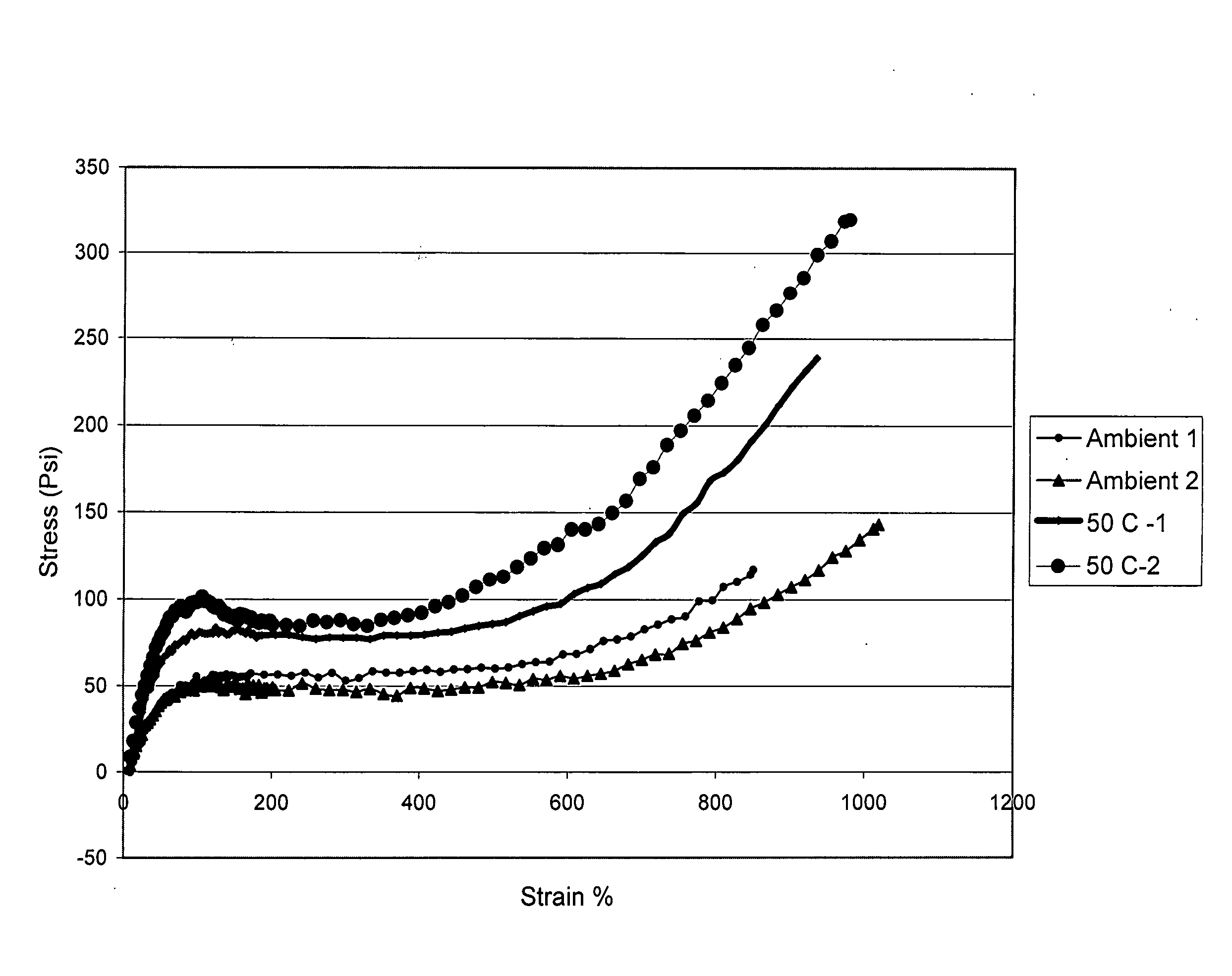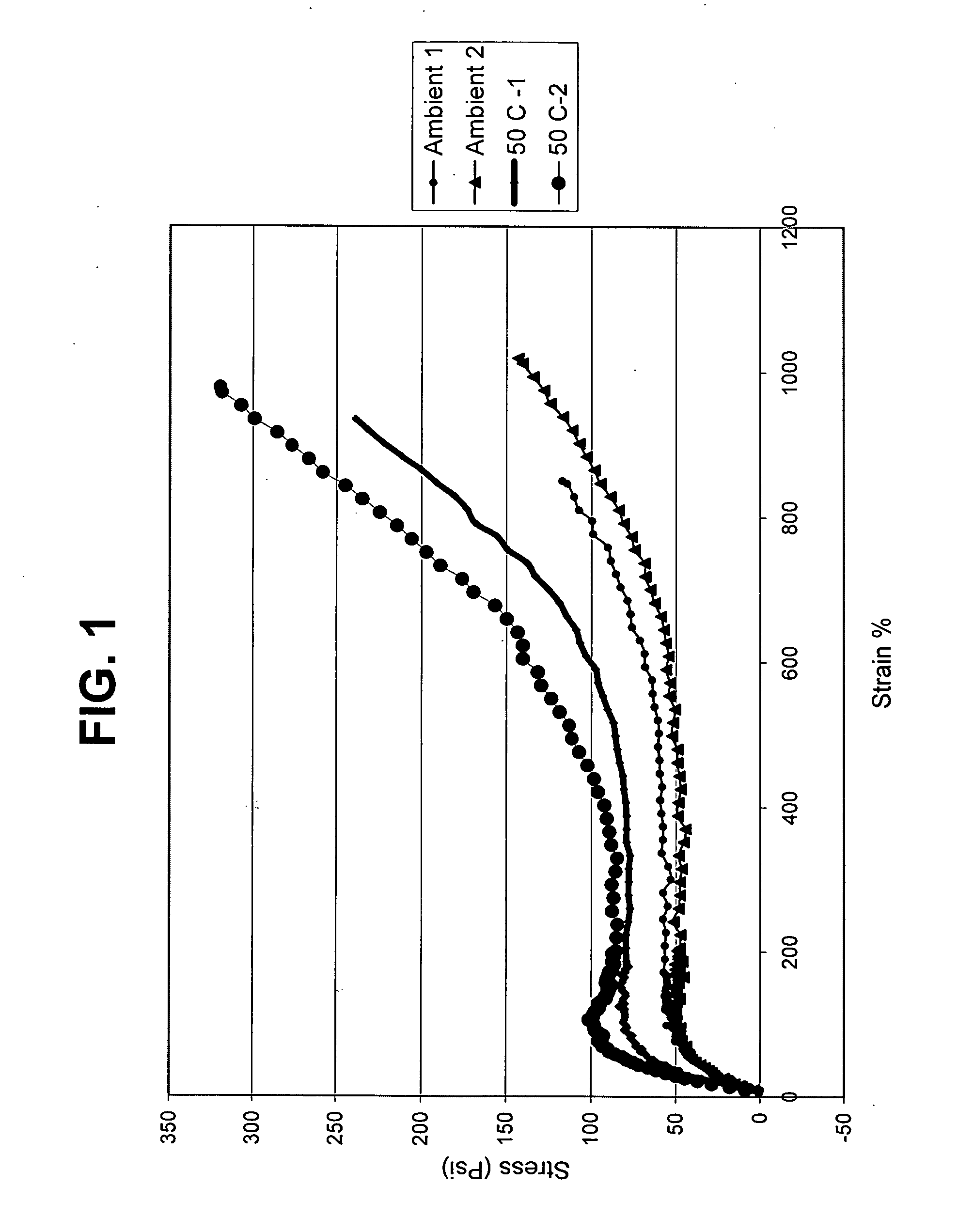Spray-in latex foam for sealing and insulating
a technology of latex foam and spray foam, applied in the field of latex foam, can solve the problems of difficulty in breathing, rise in the level of moisture and air pollutants, and conventional polyurethane spray foam, and achieve the effects of reducing the amount of spray foam
- Summary
- Abstract
- Description
- Claims
- Application Information
AI Technical Summary
Benefits of technology
Problems solved by technology
Method used
Image
Examples
example 1
Styrene Butadiene Latex Foam Composition
[0089]
TABLE 1ItemPartComponentWeight Percent1A30 / 70 Styrene Butadiene78.4Copolymer (65%) latex2APotassium Oleate (20%) soap1.33ALaponite ® RD thixotropic clay34AAmmonia0.35ANano-sized graphite26AZinc Oxide (50%)5.07BSodium Silicofluoride (20%)6.48CCarbon Dioxide3.69CAirAs required for density
[0090]In this Example, the latex system includes an SBR latex emulsion. Typically, the ammonia is already part of the latex emulsion; however, it is shown as a separate component in this Example. As previously discussed, the ammonia is used to adjust the pH of the latex to create a stable colloid. In addition to the SBR latex emulsion, the latex system in this Example also includes a thixotropic agent. It is to be appreciated that although Laponite® RD thixotropic clay is used in this Example, other Laponite® clay products could be used in this Example provided that the clay “freezes” the water structure while the carbon dioxide finishes coagulating the la...
example 2
Polychloroprene Latex Foam Composition
[0091]
TABLE 2ItemPartComponentWeight Percent1APolychloroprene (59%) latex75.82AZinc Oxide (50%)6.73ALaponite ® XLG thixotropic clay4.54AAmmonia0.675AP,p′-dibenzoylquinone dioxime (50%)1.86ASodium dibutyl dithiocarbamate (25%)1.87BCatechol (50%)0.898BFoam stabilizer (15%)0.39BSodium Silicofluoride (20%)4.510CCarbon Dioxide3.011CAirAs requiredfor density
[0092]In this Example, the latex emulsion includes a polychloroprene latex. In addition to the latex emulsion, the latex system in this Example includes a thixotropic agent. The latex system also includes zinc oxide as a foam stabilizer, and p,p′-dibenzoylquinone and sodium dibutyl dithiocarbamate as accelerators for the coagulating process. Catechol functions as a gel sensitizer and as an accelerator. The foam stabilizer may contain C-cetyl betaine with a wetting agent and sodium alkyl sulphate. The gaseous coagulant of carbon dioxide and air is metered into the mixing head. All of the B component...
example 3
Natural Rubber Latex Foam Composition
[0093]
TABLE 3ItemPartComponentWeight Percent1ANatural Rubber (60% ammonia preserved)832APotassium Oleate (20%) Soap13ALaponite ® RDS thixotropic clay14ANano-sized graphite25AZinc diethyl dithiocarbamate (50%)16AZinc mercaptobenzythiazolate (50%)0.759BZinc Oxide (50%)2.910BSodium Silicofluoride (20%)2.511BDiphenyl Guanidine (50%)0.312BAmmonium Chloride (20%)0.511CCarbon Dioxide512CAirAs requiredfor density
[0094]In this Example, the latex system includes a natural rubber latex emulsion. The latex system also includes Laponite® RDS thixotropic clay as a thixotropic agent. Additional components of the latex system are an opacifier (nano-sized graphite), a foam promoter (potassium oleate), and accelerators. In this Example, the diphenyl guanidine and ammonium chloride act as foam stabilizers. All of the B components may or may not be encapsulated.
PUM
| Property | Measurement | Unit |
|---|---|---|
| Density | aaaaa | aaaaa |
| Fraction | aaaaa | aaaaa |
| Fraction | aaaaa | aaaaa |
Abstract
Description
Claims
Application Information
 Login to View More
Login to View More - R&D
- Intellectual Property
- Life Sciences
- Materials
- Tech Scout
- Unparalleled Data Quality
- Higher Quality Content
- 60% Fewer Hallucinations
Browse by: Latest US Patents, China's latest patents, Technical Efficacy Thesaurus, Application Domain, Technology Topic, Popular Technical Reports.
© 2025 PatSnap. All rights reserved.Legal|Privacy policy|Modern Slavery Act Transparency Statement|Sitemap|About US| Contact US: help@patsnap.com


